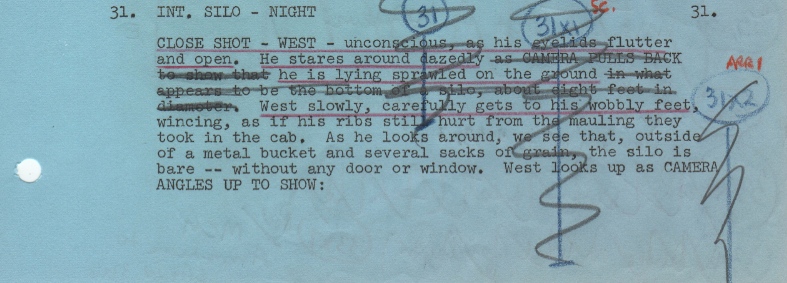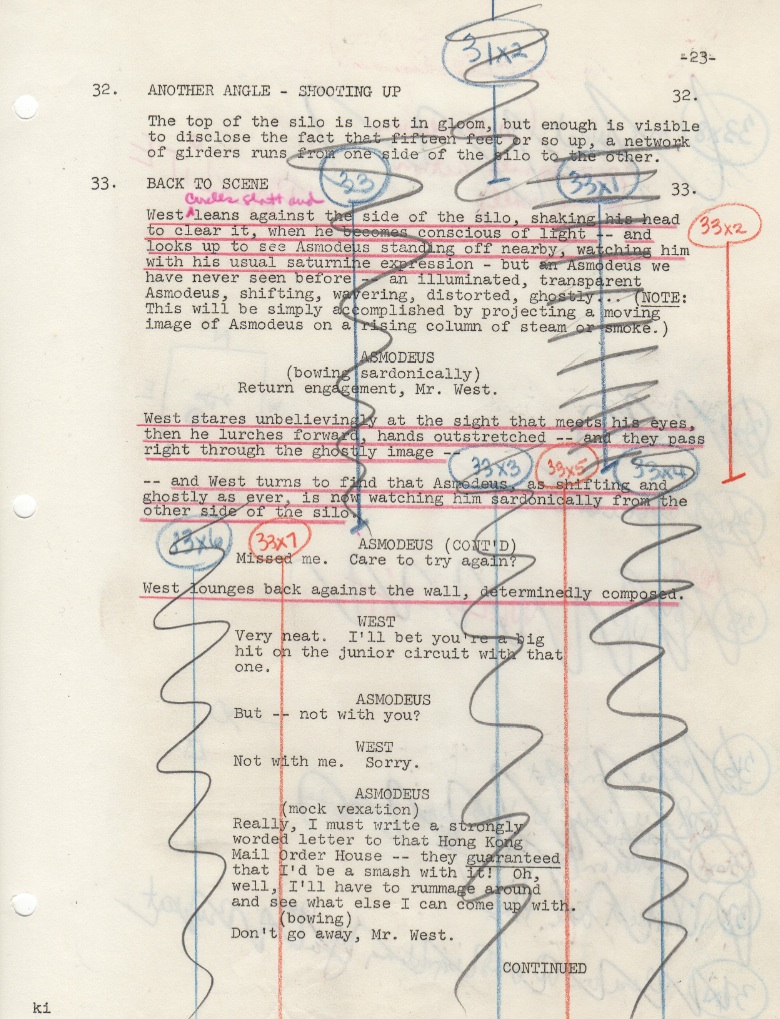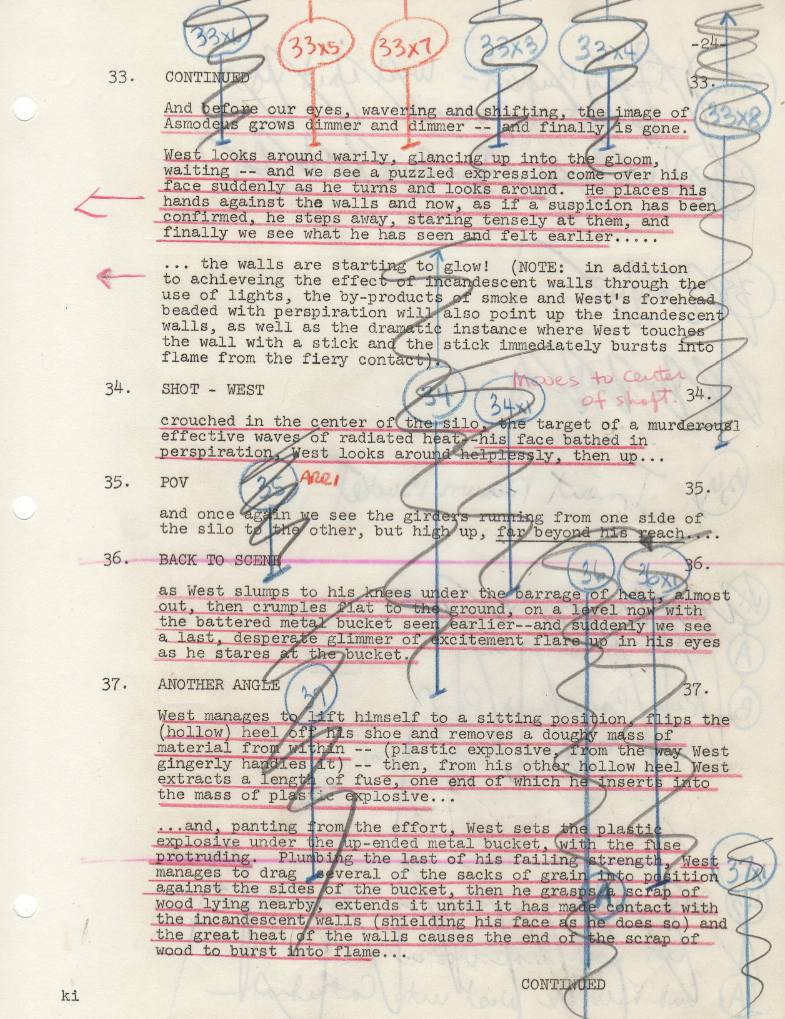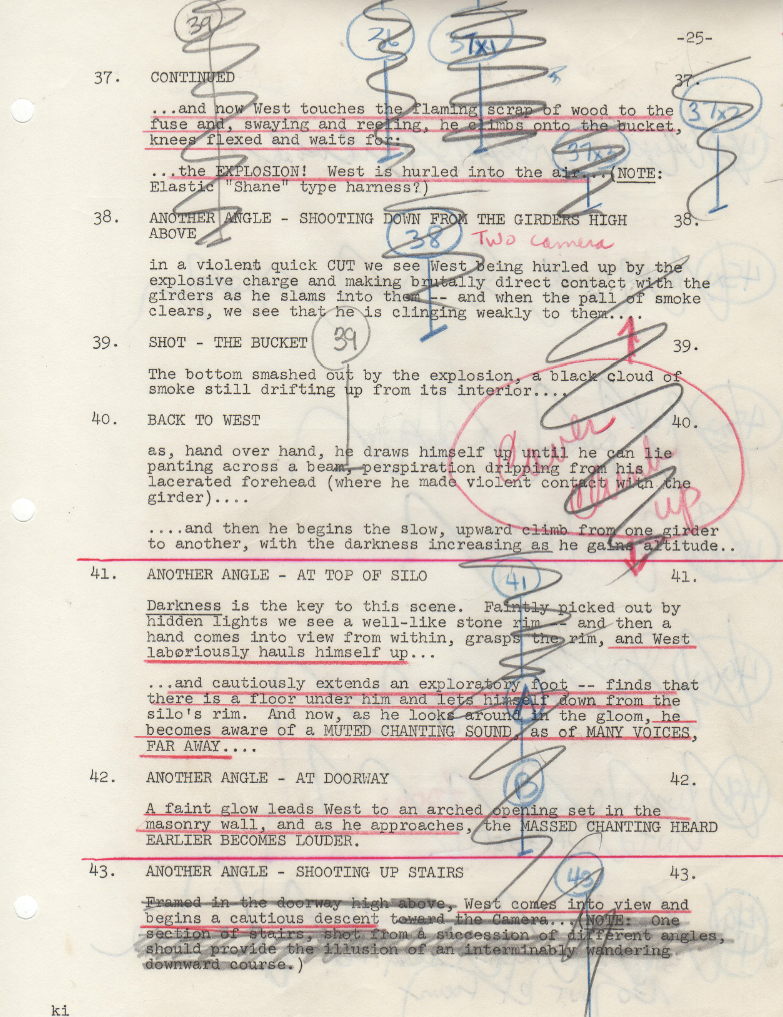FILMED February 1966
And so we have completed the first leg of our journey and have arrived back at STAR TREK where this journal began. But before we continue on to my endeavors after STAR TREK, there are some skipped-over episodes to explore. As I have stated, except for the six months I was exclusive to THE FBI, my normal trek was moving from studio to studio, from show to show. So let’s rewind to early 1966, to when I had just completed THE PLUNDERERS, my second THE FBI.
Yes indeed, filmed television in the 1960’s sometimes made for strange bedfellows — how else to explain my being booked to direct an episode of THE WILD WILD WEST. My resume at the time was loaded with films about neurotic, suffering people bearing baggages of angst. I had been tagged in a great many circles as being a “sensitive” director. Let me explain that in Hollywood that was not a compliment. And the wild west script I was handed was for a film that Robert Conrad in his commentary on the released DVD album for the first season states, “This is definitely one of the more bizarre episodes of THE WILD WILD WEST … so get ready for THE NIGHT OF THE DRUID’S BLOOD.”
Professor Robey was played by Don Beddoe. I did not realize at the time the extent of his filmography. That was the benefit of having experienced casting directors. Don was a true Hollywood veteran. He had been in films for almost thirty years and was a member of that vast army of talented performers I have spoken of who never achieved stardom, but whose faces were recognizable because of the frequency of their screen appearances. With the advent of television he would continue to perform for almost two more decades. He died in 1991, just a half a year shy of his one hundredth birthday.
In contrast Sam Wade as Robert, the young student, was making his first appearance on screen. According to the Internet Movie Data Base Sam appeared in two more television shows and then disappeared from the profession.
Simon Scott was part of the new breed of Hollywood hopefuls, never a star but a formidable presence for many years on television and cinema theatre screens. I had known Danny (his real name was Danny Simon) since 1955 when I did the lighting for a production of Maxwell Anderson’s SATURDAY’S CHILDREN at the Players Ring Theatre in Hollywood. Danny starred in that production.
The first day of filming went smoothly — almost ten pages completed and we were right on schedule. But the excitement and fun began halfway through the second day with the arrival of Don Rickles to play Asmodeus, our satanic magician. Don was a fanatically conscientious actor, deadly serious about his craft. But that was only during rehearsals and filming. Rickles between shots was the funnyman in charge. Between takes those final four and a half days seemed more like a Las Vegas showroom than a film set. Don was always on. With his incredibly sharp wit and acute skills of observation no one was safe. Robert Conrad was not the tallest creature on the planet, but according to Rickles, even with lifts in the shoes he wore, he barely reached the height of Billy Barty. Rickles was merciless, but funny. Everyone on the set was his potential next victim. Well that was almost everyone. For some reason Don never targeted me. I wonder if it was because he realized which side of the bread his close-ups were buttered on.
This was my introduction to the great Rhys Williams, our Dr, Tristam. A few months later he would guest star in THE ASSASSIN, the best of the sixteen THE FBI’s I directed. The following year he would guest star for me in the Emmy award winning THE TRAIN on MISSION IMPOSSIBLE. Rhys, who had been a Hollywood fixture since his film debut in John Ford’s Oscar winning HOW GREEN WAS MY VALLEY in 1941, was afflicted with crippling arthritis.
THE NIGHT OF THE DRUID’S BLOOD was a mini-reunion for me with director of photography, Ted Voigtlander. Four years previously Ted had filled in for Harkey Smith for three days on HASTINGS’ FAREWELL on DR. KILDARE. Ted was another cameraman who had previously been a camera operator (at MGM) and with the advent of television had become a distinguished director of photography and eventually the possessor of sixteen Emmy nominations and four Emmy statues.
The ten pages of exteriors that were filmed the first day on the CBS Studio Center backlot in Studio City were all night sequences, but filmed day for night, something that had been a no-no for Quinn Martin.
This was my introduction to the great Gene Coon, producer of the series, and writer extraordinaire, who would a year later fill those same positions on STAR TREK. It was on this series that Gene told me that because of the uniqueness of the series, he rewrote most of the scripts; that he used the writer’s first draft submission as a frame for him to build on as he did the rewrite. There was a four and an eighth page sequence that was an illustration of the fine detailed descriptive writing that came out of his typewriter.





Gene’s writing was remarkably clear and illuminating. A director seldom expected more and rarely received as much.
I remember that Michael Garrison was very impressed and vocal in his appreciation for the silo sequence. He kept saying, “That long sequence and with no dialogue.”
Conrad did all of his own stunt work. However he did not make that high leap from the pail to the girder overhead. We filmed him hanging from the girder and then dropping. In the editing room the film was reversed.
And I must point out the enormous contribution to this sequence by the fine photography of Teddy Voigtlander and the art direction of Albert Heschong. Al was another reunion for me; he had been one of the alternating art directors those many years before on PLAYHOUSE 90. Al really had his work cut out for him on this series. Unlike most series, there was only one standing set, the train that was home for James West and Artemus. It was not a large set but it was beautifully designed and provided fine opportunities for staging.
I would hate to count the number of real graveyards I filmed in during my career. The graveyard for this show was designed by Al Heschong and built on Stage 12 at CBS Studio Center. This studio incidentally was the old Republic Studio, where John Wayne (before he became a superstar) was under contract in the thirties and where Vera Hruba Ralston tried to duplicate on ice the stardom achieved by Olympic champion Sonja Henie at Twentieth Century Fox. She didn’t!
THE WILD WILD WEST was similar to THE FUGITIVE. Although it was a weekly series, its production requirements were more like those of an anthology with the only standing set being the interior of the train. That provided a formidable challenge for art director Al Heschong. Each week he was faced with the problem of providing a wide array of new sets and because of the nature of the show, most of them were large, usually opulent and as in the case of this show, some of them were weird.
Bob Conrad did all of his own stunt work in that sequence, in fact in all sequences. But we had a stunt double for Don Rickles. Don did do the closer angle shots and I remember that he was not as adept physically as he was mentally. I especially remember the angle where he climbed into the chest and closed the lid. That bit of business took take after take and it was almost as funny to see the bad takes as to hear some of his insulting dialogue. But we finally got it.
I have viewed many episodes of the first season and most of them were wild wild WESTERNS. THE NIGHT OF THE DRUID’S BLOOD was definitely NOT a western; it was more the sixties’ James Bond meets the thirties’ mad scientist.
THE NIGHT OF THE DRUID’S BLOOD was the last black and white film I would direct. My second THE WILD WILD WEST was in color. And if you thought our scientist this time was far out, wait till you see what’s in store for you. It’ll be Ida Lupino playing a scientist who was almost a reincarnation of Dr. Frankenstein. That’s next!
The journey continues



Ralph – Two things – One, the first garden scene between West and Astarte is so beautifully staged it seems like a dance (I think I counted 7 set-ups including Artemus’ entrance) – your editor must have been very, very happy! I look at today’s ‘single-camera’ shows shot with multiples, taking hours and hours to set up and none look so seamless as this (take a look at the cut where Astarte turns and sits into the shot).
Two – in the escape from the silo, Gene’s pages indicate a very desperate (perspiration, etc) escape by West, yet it’s played very cooly — whose decision was this? It’s wonderful. Did you get any comments regarding this by Gene or others?
There were no adverse criticisms regarding the silo escape scene. And Mike Garrison was overly enthusiastic in praising it. As I wrote above, he couldn’t get over the fact that the long sequence worked and without dialogue.
And for the first scene, you are right. It was 7 set-ups
Ralph…just read the WILD WILD WEST entry. Loved seeing the script and then the sequence…very illuminating as to your talent and approach. (were the script pages from the script supervisor?) I LOVED the extreme low angle of West as the fuse to the bucket burns closer. I have a question…could you go to the production manager or the AD and ask for more time than originally allotted for a particular scene? I.E. you tell them, “I want to make a meal out of the silo sequence, and we will still be on schedule because I can stage a later dialogue scene in one simple set-up” , etc? How much control to the allocation of time in a given episode production schedule would you typically have? Also, whenever I see your work in the context of today, it makes me very grateful to your generation, as you really show true craft in your work, unlike so many shows today which have the mindset of “hosing the actors down with four cameras” and then stitching it together editorially rather than conceptually from the beginning, with the blocking and the camerawork and the performances combining to tell the story. That doesnt mean that directors today are untalented, but it is the METHOD of working that is amiss, and I am sure the showrunners are more to “blame” than anyone! You must write the book…heck, you already have! But it would be great to collect all your entries in book form, with a companion dvd for future filmmakers. Keep up the great work on this site…as I have told you before, it is a true pleasure to read and watch, and I learn something each time! Hope you are doing well and here’s to happy holidays for you and yours. All the best, Jeff Burr
Jeff,first off, the pages I printed are from MY director’s script. All of the notations on the script were put there by me. You’re not the first person to confuse one of my scripts with that of the script supervisor. And many thought I had been one. I will admit my method of preparing my script was based on seeing how script supervisors did theirs.
To answer your question about the time, I would see the production board breakdown before the schedule was printed so my input would happen then. The production managers of the day were all very knowledgeable guys and rarely overloaded. If they did, we just went over.
Was Simon the same actor who played the hospital administration guy in “Trapper John M.D.”?
Indeed he was.
This was a very campy,fun episode in a very original series. This episode did remind me of the cult classic DONOVAN’S BRAIN. The silo scene was marvelous. Conrad was the “James Bond of the West!” The only part that confused me was the character that was all bandaged that replaced West. Who was he? Thanks again for the superb commentary.
The bandaged stand-in for West was part of the conspiracy. Did you realize that it was Robert, the Professor’s star pupil, who went with him in the ambulance?
No, I missed that switcheroo. I watched it again, and then realized Robert was part of the conspiracy. After all, he did place the robe on the Professor. Thanks for setting me straight, Ralph. These shows are worth multiple viewings, anyway.
Ralph, I own the DVD box set of ‘TWWW’, along with the revised CD/.pdf version of the book written about this series by Susan Kesler. That means I have a ton of questions and comments, but I will be polite and not overwhelm you with ALL of them! Thanks in advance.
In the silo sequence (8th video), you had a shot of West on the bucket with the camera pointed upward from the floor (at 3:40) and you can see the underside of the fuse. How did you do that? I have a couple of guesses, but I’ll let you answer.
In the 12th video, what was the “aqueous solution” in the brain bowls? It has to be something that bubbles well. Cola? Grape Juice? By the way, the set decoration detail of Dr. Tristam’s office was amazing. Until now, I never noticed that he had live rodents in a cage on a table (at 1:02 & 6:04).
FYI, the Kesler book has a couple of color out-take photos of West and Gordon opening the door to the chamber of robed dummies. They were taken by wardrobe man Jimmy George (he sometimes doubled R. Conrad in season 4). It also has a B&W pic of Ann Elder and Don Rickles chatting with Mike Garrison. Lastly, it has one of this episode’s call sheets, along with one call sheet from ‘Big Blast’. Unfortunately, these photos are small and hard to read, even after you magnify them.
I was not aware that Gene Coon did extensive re-writing on this series. The IMDB record says he produced six episodes, but took a writing credit for only one episode, “TNOT Freebooters”. His career output was just incredible.
I noticed Scene 46 of your script says Astarte has streaming BLACK hair…ha ha, not after opening a Clairol bottle! It was so fitting that Astarte was made up like Marie Antoinette in her last scene…it went over my head the first time I watched this episode. Ann Elder is REALLY good in this show…if I made up a list, she’d be in the top-5 of all the villainesses in this series.
Hi Phil: I may have to hire you to come sit with me as I prepare my posts. You always have such interesting and illuminating questions. To start with:
” In the silo sequence (8th video), you had a shot of West on the bucket with the camera pointed upward from the floor (at 3:40) and you can see the underside of the fuse. How did you do that? I have a couple of guesses, but I’ll let you answer.”
The camera was mounted on a “high hat”, a camera mount that sat on the floor. The pail was set on a small platform that was raised enough that the camera shooting up could get the shot you see.
“In the 12th video, what was the “aqueous solution” in the brain bowls? It has to be something that bubbles well.”
I don’t know the answer. The special effects men on the set were always magicians. They always seemed to deliver even more than the script requested, and as long as it worked, I didn’t question.
“I was not aware that Gene Coon did extensive re-writing on this series.”
I think Gene Coon is one of the unsung heroes of television. Both on this series and later on STAR TREK his work (and he was a rewriting machine) set a standard that elevated both series to levels that were seldom reached after his departure.
Ralph, thanks for the offer, but you’d have to cover my travel expenses…3,000 miles each way! Anyway, this is fun, not work!
Just one more question: Were you present for the creation and application of the optical effects (the disappearing watch, the fire killings)? I’m guessing the answer is no.
And you’re correct.
Ralph, I have a couple of questions about the 7th video, thanks.
First, we see our heroes come out of the big building on the corner. Over four seasons, West and Gordon wore out their boots going in and out of that structure. In this case, it was someone’s home, but it was a hotel in most episodes. At other times, it was the Denver Mint, the Secret Service Training Academy, the Territorial Communications Center, a museum, etc. Did this building have any productive floor space on the inside, or was it just an empty hulk? Feel free to ruin my childhood fantasies!
Second, bravo to the video from 1:23 to 1:27 – the picture dissolved from the big ambulance wheel on the street to the big gurney wheel in the hospital. I’m a junior member of an online forum that studies this series with a microscope. The scene is a small artistic dab on the canvas, but hardcore fans notice it AND appreciate it. Now for the questions…how was it done? Was it spelled out it in Gene Coon’s re-write or did you think of it? Also, would the film editor create the dissolve scene immediately for the dailies you reviewed, or would it happen in post-production after you left?
THE WILD WILD WEST was filmed at CBS Studio Center in Studio City, the lot that once housed Republic productions. It was a small lot with a very limited backlot, so the reappearance of that structure in so many episodes was of necessity. And since you’ve given me permission, I herewith ruin your childhood fantasies; the building was an empty hulk. As for the ambulance wheel to gurney wheel dissolve, that was not in Gene’s script, and the actual dissolve was done in the lab later, although it was planned and designated on the work print by a marking on the film.
I first saw The Wild Wild West when it ran in syndication during the 1970s and was delighted when the series came out on DVD. The silo escape scene is a favorite of mine. 🙂
Ralph,
I was never a Wild, Wild West fan but I love your comments on working on the series and in particular the actors you worked with. As always, your comments on their strengths (and sometimes weaknesses) are spot on.
It was nice to read your comments on Simon Scott, an actor I first noticed him in the Lon Chaney biopic, Man Of A Thousand faces, in which Scott has a small role as a suitor of Chaney’s first (mentally disturbed) wife.
Jimmy Cagney as Chaney was rough on Scott’s character, who was backstage, formally dressed in a long overcoat, and when he got aggressive (as was the custom with Cagney) he either punched or knocked down Scott, who, rather than fight, fell backwards, on the floor: you see, he had no legs, just what looked like extended venetian blinds!
The effect was stunning, and for me it was the creepiest scene in the movie for a number of reasons I shall not bore you with. Once again, poor Chaney encounters a wounded, crippled person. Scott’s refined, smooth demeanor impressed me; and I never forgot his face even as it took me years to learn the actor’s name (there was no Internet back in the 60s).
Since then I’ve seen Scott in many old TV shows (not so many movies), from Perry Mason to Peter Gunn to the Hitchcock hour (he seemed to work a lot for Universal). He always impresses, whether benign or sinister; and he often comes across as something in-between. With more luck he might have had a career along the lines of George Macready, whom he sometimes strikes me as a handsome version of, but without the spooky vibes.
It’s nice to see that Mr. Scott (or Simon, as the case may be) was recognized as a gifted actor and was gainfully employed for most of his career. As a character actor, he never had that “one lucky shot” of the kind Vincent Price got, and Laird Cregar; and later on, at the starring level, Richard Widmark and Jack Palance. Simon Scott’s remembered, though, and not just by industry insiders,–the pros–but by many people who recognize acting talent and have a good head for names.
I know that I’ve written what’s basically a lengthy fan post for Mr. Scott, not about your life and career, but I think he’s worth it. Also,–LOL!–this may be the first such ever.
Sincerely, John B.
Nothing goes to waste – after the demise of Dr. Tristam, the Accumulator (12th video, 3:35 thru 3:43) was bought at a rummage sale by Dr. Faustina for “The Night of the Big Blast”.
The website tvshowsondvd.com reported this week that CBS/Paramount will be re-issuing the complete series on 5/12/2015 (the 2008 box set, which I have, is no longer being made). This is the 50th anniversary of TWWW, but what is the only enhancement mentioned with the new box set? Answer: the new packaging makes it sit better on your shelf! Not one word on a Blu-Ray version or new extra features. If that changes, I’ll post an update.
Pingback: Gene L. Coon: More than just Star Trek | The Spy Command
Pingback: Don Rickles dies at 90; credits include ’60s spy TV shows | The Spy Command
Pingback: Wonderful Behind The Scenes TV Stories From Prolific Director Ralph Senensky | Professor Wagstaff
I just read this page last week. Tonight I watched the second episode of Buck Rogers (1979): Planet of the Slave Girls. Buck escaped his lockup by putting a helmet over a grenade (not hidden, luckily they didn’t search him) and flying to the rafters. It was far less believeable.
Pingback: 6 Mantras That Mattered - Ralph's Cinema TrekRalph's Cinema Trek
LOVE this episode. This script grabs you from the start.
Ann Elder is amazingly good; such a unique performance.
She’s such a refreshingly complex and unapologetically EVIL femme fatale.
The interior train hallway shot is fantastic. I finally understand the layout of their train.
Rhys Williams’ performance in the final reveal is also Pure Gold.
Thank you! Susanna